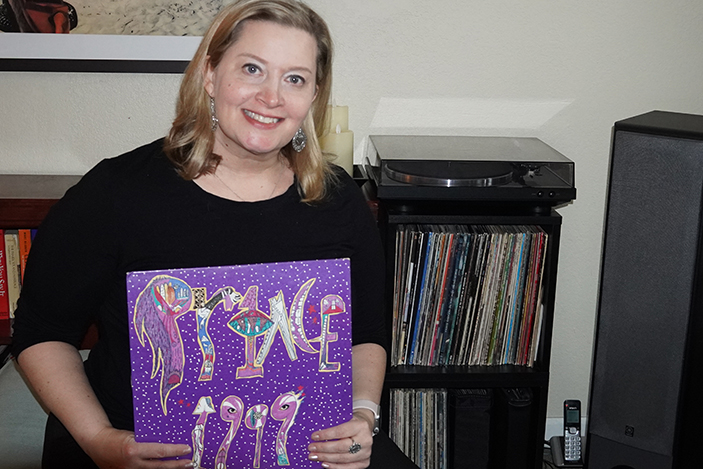Melanie Cryer is part of the Ursus family, but she’s not an Oski fan, the mascot of UC Berkeley. She is a proud Bruin from the other end of the state, UCLA, and is active in the Bay Area Bruins network. She’s found a few UCLA alumni at the Lab and is always interested in connecting with more of them. She continued her tour through the UC system, receiving her MBA from UC Irvine and added certification as a senior professional in human resources (SPHR) during the pandemic.
When she’s not rooting for her Bruins, she collects vinyl. One of her cherished albums is Prince’s album “1999”, which she keeps center stage in her LP collection.
At work, she’s been concentrating on developing and testing a new course on timekeeping, which needs to be completed by all employees by April 30.
Q: Why is timekeeping essential at the Lab?
A: We all must report our time because we have contract requirements. We must ensure the hours we input and credit to activity codes are correct. Incorrect timekeeping is potentially a misuse of funds and would violate our contract.
We may need to include employees in audits from time to time where employees may be asked to answer questions or may have their time reporting looked at in more detail. So we need to know what we’re doing. We expect an audit this year from the Office of the Inspector General. It sounds intimidating, but you’ll be more prepared after you take the course.
Q: What’s the objective of the course?
A: The objective of the course is to provide a knowledge base of policy and procedures relating to time. We’ve had courses that deal with the actual physical input of your time, but we realized those courses didn’t cover Lab policies. Some of the questions that may come up during an audit were not covered anywhere in our existing training, so we put together a course that started as more of an interactive FAQ and became more scenario-based questions and answers to help provide employees with not just the knowledge and the policy they need to know, but also some examples of what that may look like in their day to day life.
The audience for the course is anybody who fills out a time card in LETS.
Q: Will this be a one-time course, or will we repeat the training regularly?
We need to work out this with our compliance team and our leaders at the Lab to discuss how often we need to offer this training. It will be part of onboarding for those new to the Lab.
Q: Do you usually design instructional courses for the Lab?
A: I’m an instructional designer responsible for the design and upkeep of existing courses offered by the OCFO. I aim to ensure people finish a course with more knowledge than when they started.
Q: How do you start designing a new course?
A: I’m interested in the different ways people learn. Are they an auditory, visual, or kinesthetic learner? As a designer, you need to incorporate all of those modalities. There is a visual component any time you read or watch a video. About 20% of people are audio learners. So, in this course, you’ll notice that we have optional audio to read the text on the screen. The kinesthetic component would be when you answer questions.
That’s why we find that the completion time is sometimes hard to estimate on courses because, for somebody who is a speedy reader, they’re not listening to those audio snippets. They may go faster than somebody who wants to use the audio. That’s the challenge of designing instruction. You want to keep the course manageable, but you also have to realize people learn at different rates and in different ways.
Q: What are the challenges in course design?
A: One of the challenges is trying to make our classes more relevant by bringing in the human element into a course when the subject might be dry, like timekeeping. We used our senior leaders in an opening video to stress the importance of the topic. It was also a great team effort from our project team, including compliance and payroll people. We piloted the training with several groups who provided critical feedback. It showed us the areas that needed more information and where there was too much content. We piloted it again late last year with a group of managers, so we made a few more changes before its launch. The course keeps getting better with each incarnation.
Q: What are you asking employees to do with this course?
A: Block out an hour to take the course. It won’t take that long, but we want you to have time to absorb the information. Don’t try to multi-task on this one. The training may spur you to review your timekeeping records and ensure you’ve used the correct codes.
And then, there’s the upcoming audit you’ll hear about in the training. The audits are referred to as floor checks. The auditors will interview a random selection of employees. Those who had already taken the pilot course reported a 29% increase in their timekeeping knowledge.
The audit interview will last about 15 minutes. We don’t have details of when they will occur or how people will be selected, but those selected will receive advance notice. Auditors will ask how you charge your time, and this course will hopefully help prepare employees to answer those questions and feel confident.
I recommend people take the course as soon as possible because we don’t know when the audit will happen. But you’ll want to be prepared in advance.
